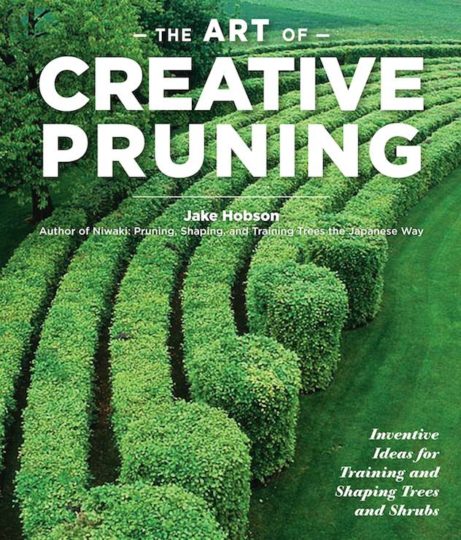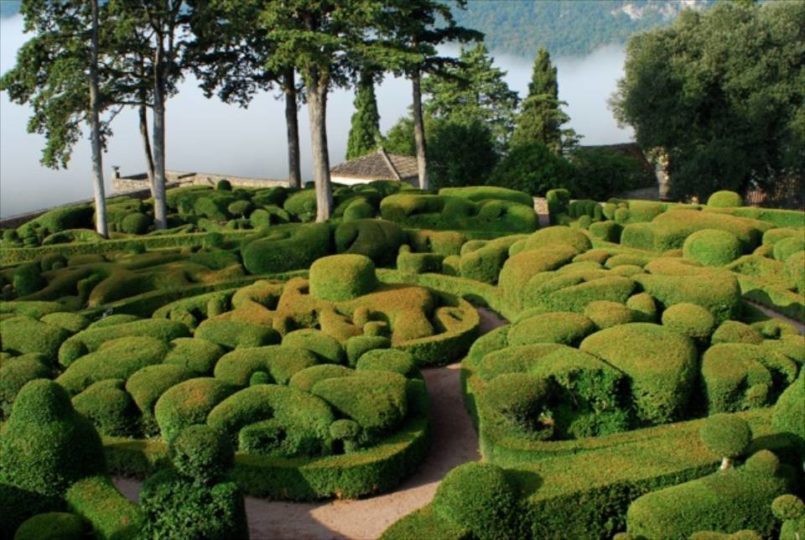It all started with a very dishy pair of secateurs….
Through his Japanese garden tool business, I first came across sculpto-anything-green man; Jake Hobson. Trained as a sculptor, Hobson developed his fascination for Japanese tree pruning to his distinctive naturalistic east-meets-west, free-form pruning style. Some may remember his brief appearance on Carol Klein’s Life in a Cottage garden series, where he was commissioned to cloud prune the newly established box hedge. Having admired his cloud pruning expertise with much intrigue, I was delighted to find his words of wisdom fully exposed in his new book entitled, ‘The Art of Creative Pruning: Inventive Ideas for Training and Shaping Trees and Shrubs’ (Timber press, 2011).
Hobson’s book is remarkable, providing both inspiration as well as practical advice on a vast array of pruning styles & techniques from around the world, for an assortment of tree and hedge plant varieties. ‘This book is not about topiary, not in the normal sense’ explains Hobson, and this is certainly true. Topiary pruning (blobs, balls, wedding cakes, pyramids, spirals, cones) is certainly included, but there is much more to this book than that. With great care and detail, Hobson explains pruning techniques for; hedges (buttresses, battlements, crenelations, arches, mazes, pleached hedging, raised hedges and hedge sculpturing); and trees, including common techniques such as pollarding but also the more unfamiliar such as thinning (a la Japanese), pine pruning, branch training, Tamazukuri and Fukinaoshi. Note, those looking for advice on creating animal shapes will be sorely disappointed. Hobson draws the line at animal topiary, which he amusingly defers with; ‘If that upsets you, write your own book’.
Detailed explanations and diagrams ensure that all forementioned techniques can be applied to any garden, either in their true form or ‘applied’ to local surroundings. Just think of Tom Stuart Smith’s 2008 Chelsea Show Garden where he used cloud pruned trees (Fukinaoshi) to achieve that Japanese feel, yet he did so using the very non-Japanese, native Hornbeam trees. The book is simply crammed with examples of extraordinary pruned topiary, hedges and trees in gardens all over the world, such as Marqueyssac in the Dordognes, Jacques Wirtz’s garden in Belgium, Levens Hall in Cumbria, Pearl Fryer’s garden in California, Korakuen in Okayama, and Konpuku-ji in Kyoto, but also examples from local neighbourhood gardens, tea plantations, museum gardens and even the garden at his family home in Dorset.







Prior to reading this book, my knowledge of Japanese pruning was embarrassingly limited. Bonsai was about it really and admittedly without much enthusiasm as I’m not a fan of this form of tree torture. Hobson has certainly taught me to recognise the value of Japanese gardens and pruning techniques. Most interesting is the reasoning for pruning in Japan as opposed to the West. It is true that East & West, prune to keep plants under control, maximise space, and/or if the case of fruit trees and/or (flowering) bushes, to enhance their yield. However, as Hobson explains, in the West, pruning tends to remove plants from their natural state, whereas in Japan, the aim is to manipulate and enhance their natural state, to reflect the landscape (mountains, forests, waterfalls and rocky coastlines). European traditions therefore involves control over nature, whereas Japanese traditions aim to working with nature. In Japan, plants are therefore pruned to look ‘more’ like plants, or as Hobson explains ‘to create caricatures’ of the plants themselves.
Our garden is sadly severely lacking in topiary pruning opportunities so one is a tad parched for this form of gardening amusement. Hobson compares his excitement for pruning to the buzz that Lou Reed feels when turning on his amplifier, so one can only conclude that we are seriously missing out. Now more enlightened, I realise there are additional opportunities in the form of (increasingly nervous) hedges and trees. Many years ago though, in my parent’s garden in the Netherlands, I have indulged and certainly enjoyed wielding the pruners. Reading this book, I now understand what went wrong. Despite that sounding as if it was a horrendous disaster, I’m not too bad a maker of fancy ‘blobs’, but there was one project that despite much attention failed miserably. In the garden was a lovingly cultivated, enormous box cube which we kept very trim at all times. Hobson explains that for these modern shapes to work, they must not be cut straight but left to slightly swell at the bottom. When cut straight, the bottom does not get enough light, becomes thin and eventually straggly. All that time spent trying to cut the perfect shape, we were in actual fact killing our beloved plant. Hobson is certainly to blame for its demise, as he could have decided to pen his book a few years earlier.
Despite his enthusiasm, there are many forms of pruning that will never see the light of day in our garden. Wedding cakes, battlements, mazes will remain as illustrations on the pages of this book, but the idea of a long cloud (or as Hobson refers ‘organic) pruned hedge may be on the cards. Despite looking like a rather daunting task, creating one sounds rather satisfying in that time and nature provides its character. Starting one is exactly the same as planting a normal box hedge, explains Hobson. The difference is that one lets the hedge develop at its own pace, embracing the differences in growth rate and character of the individual plants. That is, some will grow more vigorously than others, some may die. Hence providing the cloud hedge with its distinctive shape, where these differences are exploited through careful pruning. The book provides details as to short cuts and creating this organic form from an existing hedge, but the idea of starting from scratch sounds rather appealing. We may need to start taking some cuttings.
Unless one is looking to create a topiary zoo, this book belongs on every gardener’s (bulging) book shelf. Not just informative and inspirational, but also a cracking and amusing read.
Oh, and Hobson’s secateurs aren’t too bad either….
